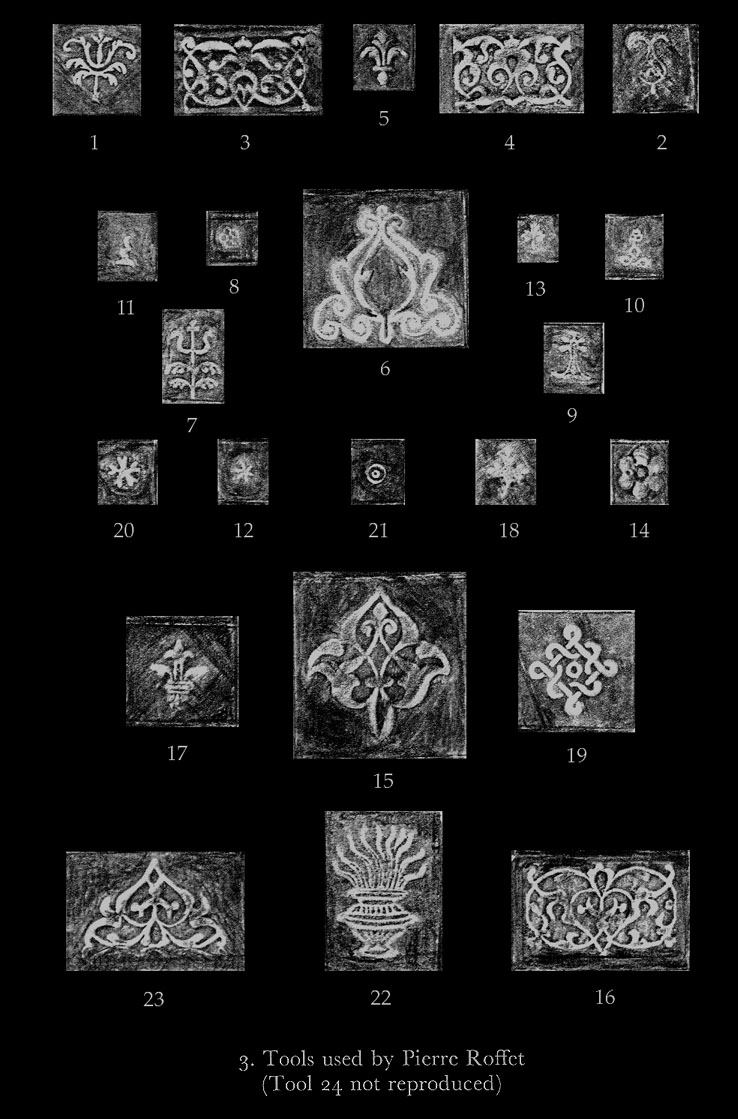

| In a 1974 article entitled: French bookbindings for Sir Richard Wingfield and Jean Grolier, published in GATHERINGS IN HONOR OF DOROTHY E. MINER. Baltimore: The Walters Art Gallery, Howard M. Nixon dropped a quiet bomb on Jacques Guignard's theory about the atelier of Simon Vostre. Guignard was convinced that the gold tooled bookbindings known as the reliures Louis XII were produced in the Paris workshop of Simon Vostre. It is a well known fact that Pierre Roffet purchased the materials from this workshop (15, January 1523) after Vostre's death in June of 1521. Guignard went to excessive lengths to show that the Louis XII tools were evident in Roffet's bindings as proof of this theory. We find in Nixon's article a complete catalogue of tool imprints that he has carefully collected from the bindings of Pierre Roffet. I have reproduced it above and you will be disappointed if you are looking for the Louis XII tools, there is not a single one, Nixon writes:"although there is documentary evidence that Roffet acquired some of Vostre's equipment I am not convinced that Roffet ever used any of Vostre's bookbinding tools." This is a polite way of saying that Guignard's theory is rubbish, further he adds in a footnote (page 307, 8.) "M. Guignard believed (Melanges offerts a Julien Cain, pp. 244-45) that a large oriental leaf-tool (no. 15 on figure 3), found on Grolier's 1499 Hypnerotomachia Poliphili at Reims and his Saxo Grammaticus, 1514 at Copenhagen, was the same as his tool O2 found on several Louis XII bindery books, I have rubbings of both tools from which it is clear that these tools are different-- the amount of space surrounding the fleur-de-lys in the upper lobe is the clearest indication. The only other link, the six-petalled rosette (my no. 14, his E3) is a common tool of such simple form that a number of indistinguishable variants could exist." |
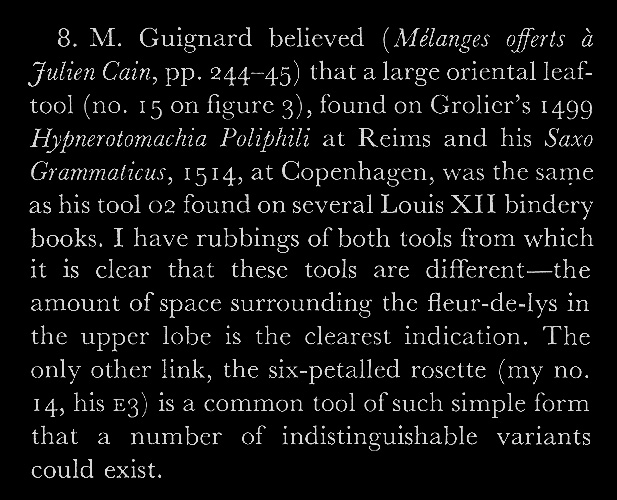
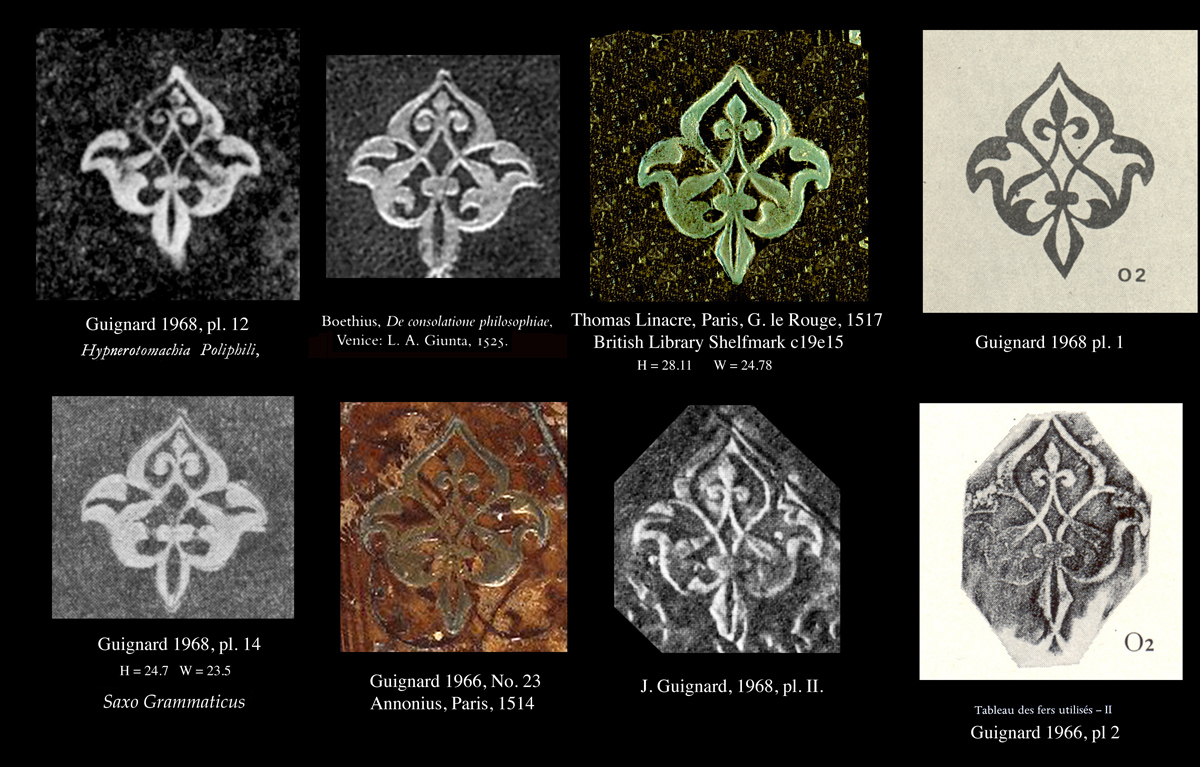
| We have already made this same observation as regards the O2 tool which is also considerably smaller than the Louis XII example (see this page). Really we need to be very precise about this tool, Nixon states: "his tool O2 found on several Louis XII bindery books" this is a matter of debate, Dacier never recorded this tool, it appears on the 1517 Linacre binding (No. 30 see this page) Thomas Linacre trad. de Galien sanitate tuenda, Paris, G. le Rouge, 1517, and No. 23, Annonius where it seems almost an after thought, barely integrated with the design as though perhaps added later by a not very adept worker. It appears on a Vostre Book of Hours, that Guignard shows on his Planche II 1968 (see below Comparative Diagram 2) this binding has the same Y tool as that of the Linacre bindings it is different from the 1515 Louis XII tool of the same type. Here we find an interesting conundrum the tools of 1515 and 1517 are completely different yet on another binding that dates from 1520 (No. 34) Recueil de pieces imprimees a Paris vers 1517-1520, we see the old crown and ecu, also on another binding (No. 37) Reliure aux armes de François Ier, that may also be from 1520 based on the broken crown and renaissance continu roulette probably the same one as found on No. 34, indicates that the atelier of Louis XII was in operation up until 1520 without changing the arms, the arms and the tools seen on the binding below and Linacre bindings may not be from the same atelier, contrary to the claims of Guignard and Nixon both were fooled by the linked circle tool, In Comparative Diagram 2, I show two bindings neither one has a common tool with the other, The larger is a distinctly atelier Louis XII binding with the same crown and ecu as found in the earliest bindings from this atelier, while the the smaller binding appears to be from a completely different atelier even though the bindings may actually be contemporaneous, Guignard claims they are both from the same atelier, that of Simon Vostre! One might ask with good reason, why would the same atelier use a different royal arms and emblems, why would they use tools that appear identical but are in fact different? |
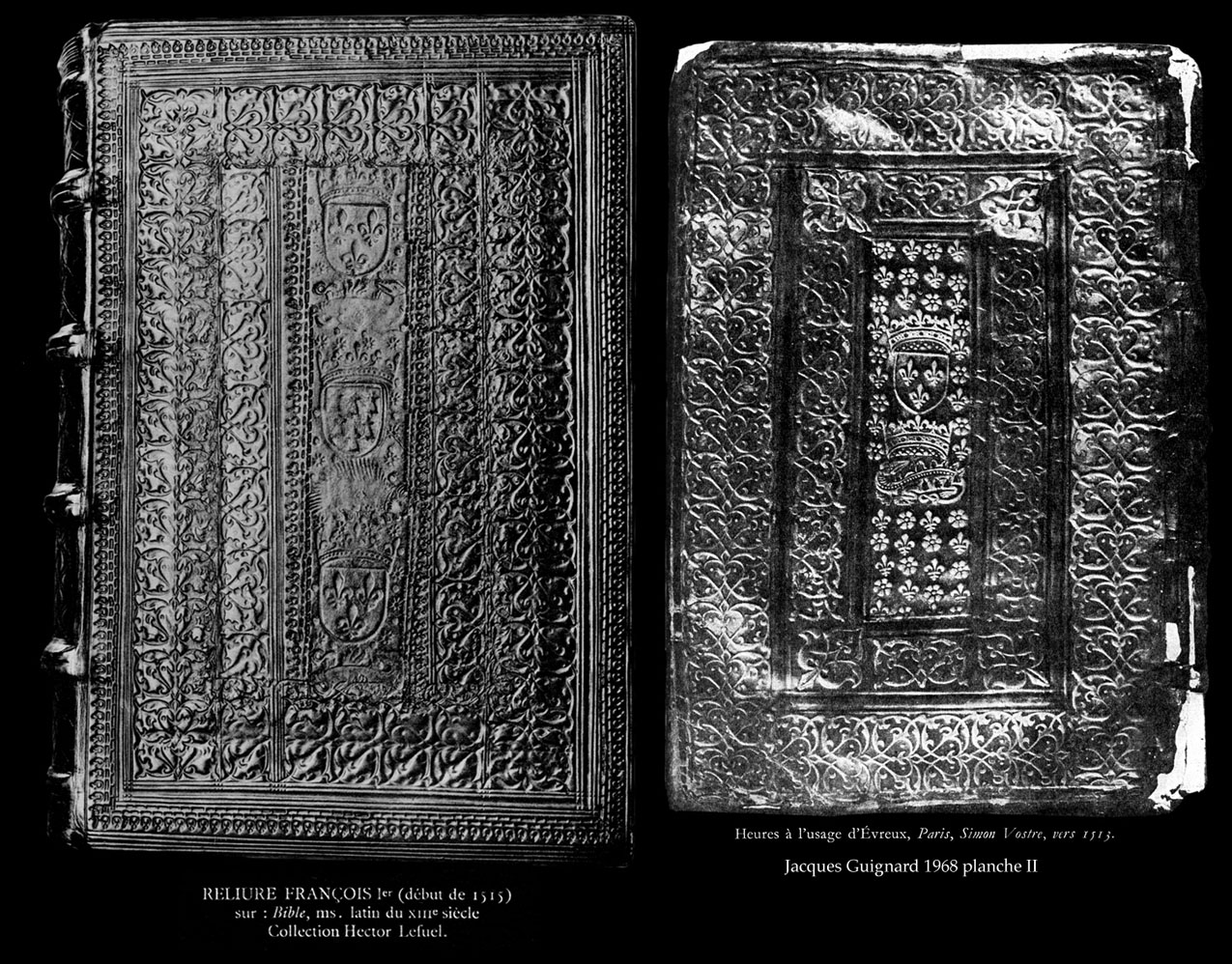
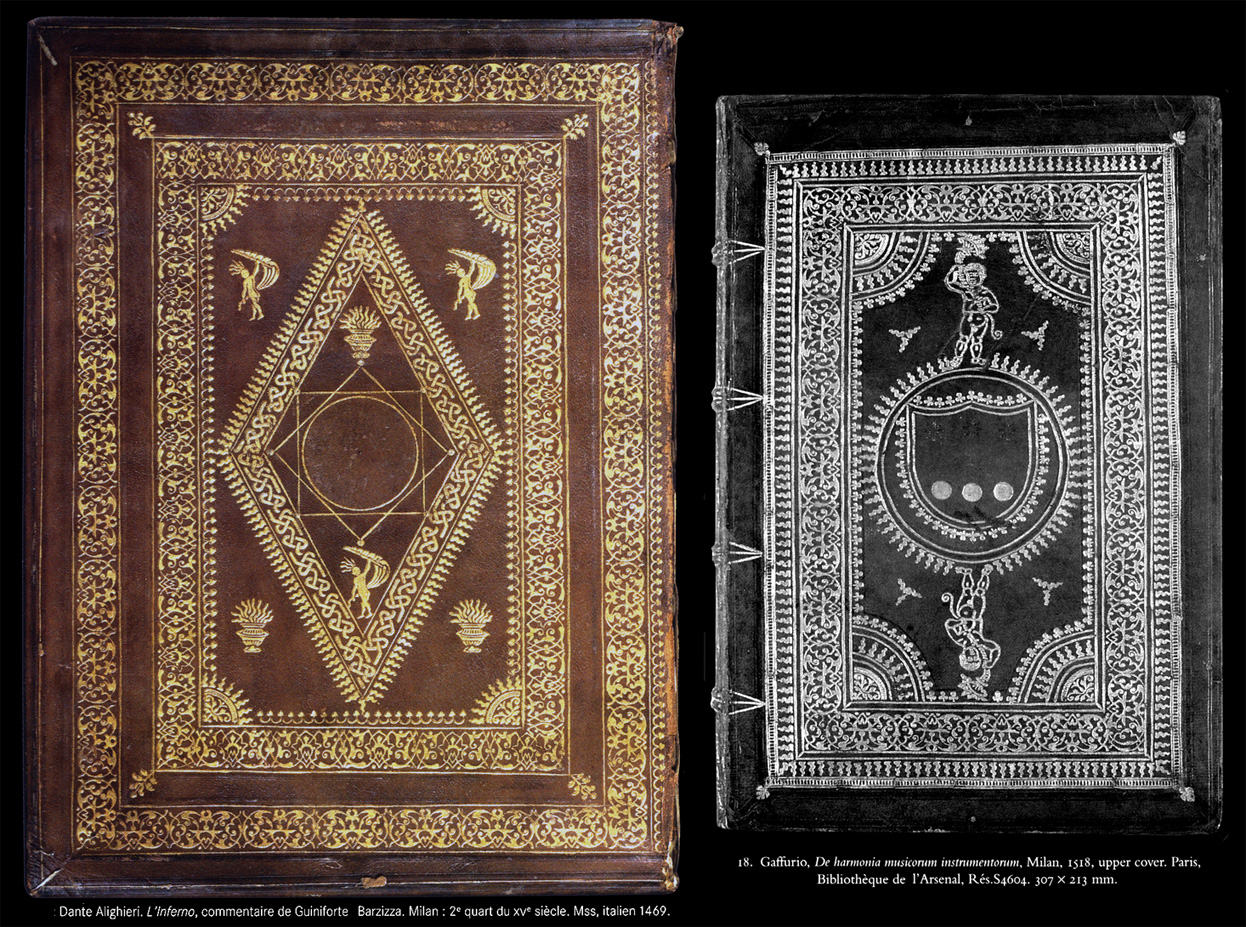
| In his 1974 article Nixon goes further in his analysis of the Pierre Roffet tools, claiming that nearly all the tools are of "purely Italian origin" and are based on those used by a binder whom Dr. Ilse Schunke has named the "Amorettenbuchbinder". The two best known bindings from this binder are the Epistolae of Saint Catherine of Siena, and De harmonia musica, Milan 1518 in the Bibliotheque de l'Arsenal, bound for presentation to Grolier and with his arms on the covers. This same binding has been reproduced by Hobson in 1999 Renaissance Book Collecting, although he does not mention Nixon in relation to it, in fact there are only 2 references to Nixon in the whole book, which would have been very hard to do. In his bibliography Hobson has listed the Nixon 1974 paper, and must have been well aware of Nixon's amorettenbuchbinder theory. In his index Hobson refers to Pierre Roffet only twice. The first occasion on page 54 while referring to the binders who worked for Grolier from 1521 to 1533. "The best documented of the binders is Pierre Roffet, active from 1511 to 1533, He had bought Simon Vostre's equipment and may have held the brevet of binder to the king." This is about a brief as he could get, well documented? by Nixon I suppose he meant. Then he mentions that Roffet bought Simon Vostre's tools! What he doesn't mention is that none of the atelier Louis XII tools are seen on the Roffet bindings, as was pointed out by Nixon, This is a strange fact that certainly makes Guignard's Simon Vostre theory look very weak. Hobson totally avoided the issue, I can only guess that it was a sort of personal favor towards Guignard. Or perhaps due to the fact that he had already committed himself to accepting this flawed theory some 10 years previously. |
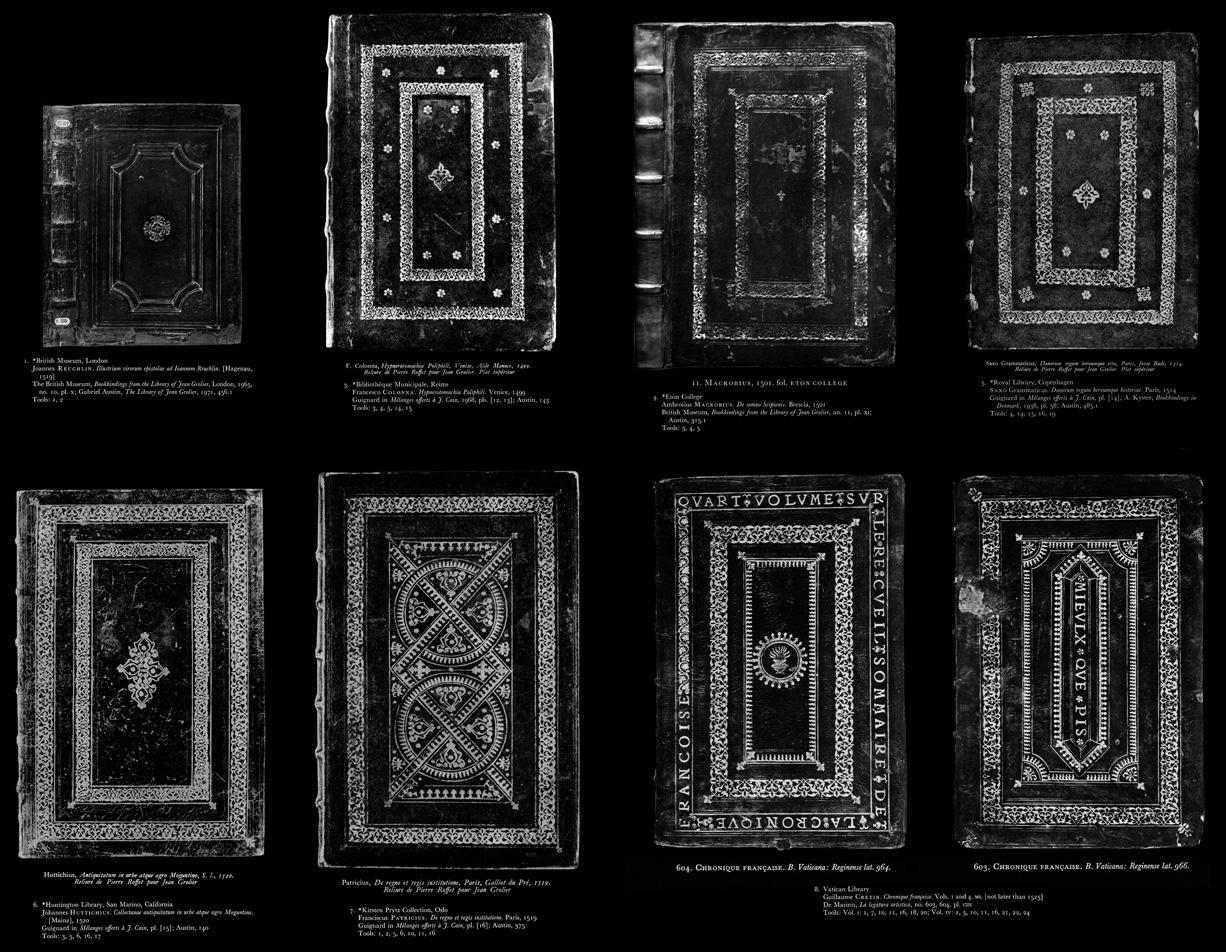
| In Comparative Diagram 3, I have reproduced two Amorrettenbuchbinder examples. In Comparative Diagram 4, I have reproduced most of the Roffet examples in Nixon's 1974 list. Roffet's tools are enumerated at the top of this page and have been listed with each binding example. There is little doubt that Roffet was emulating the amorrettenbuchbinder, perhaps as a direct result of Grolier insisting on bindings decorated with Italianate tools and framework designs that followed the Milanese patterns. A passionate researcher will want to examine Roffet bindings from his earlier pre Grolier period. A study of Denise Gid's 1984 Catalogues of decorated French bindings from the 15th and 16th centuries reveals that roulettes, in a wide range of varieties, became very popular from about 1515 onwards. Pierre Roffet appears to have never used them, unless perhaps in his pre Grolier bindings? |
| information about the author | return to the home page of VIRTUAL BOOKBINDING |